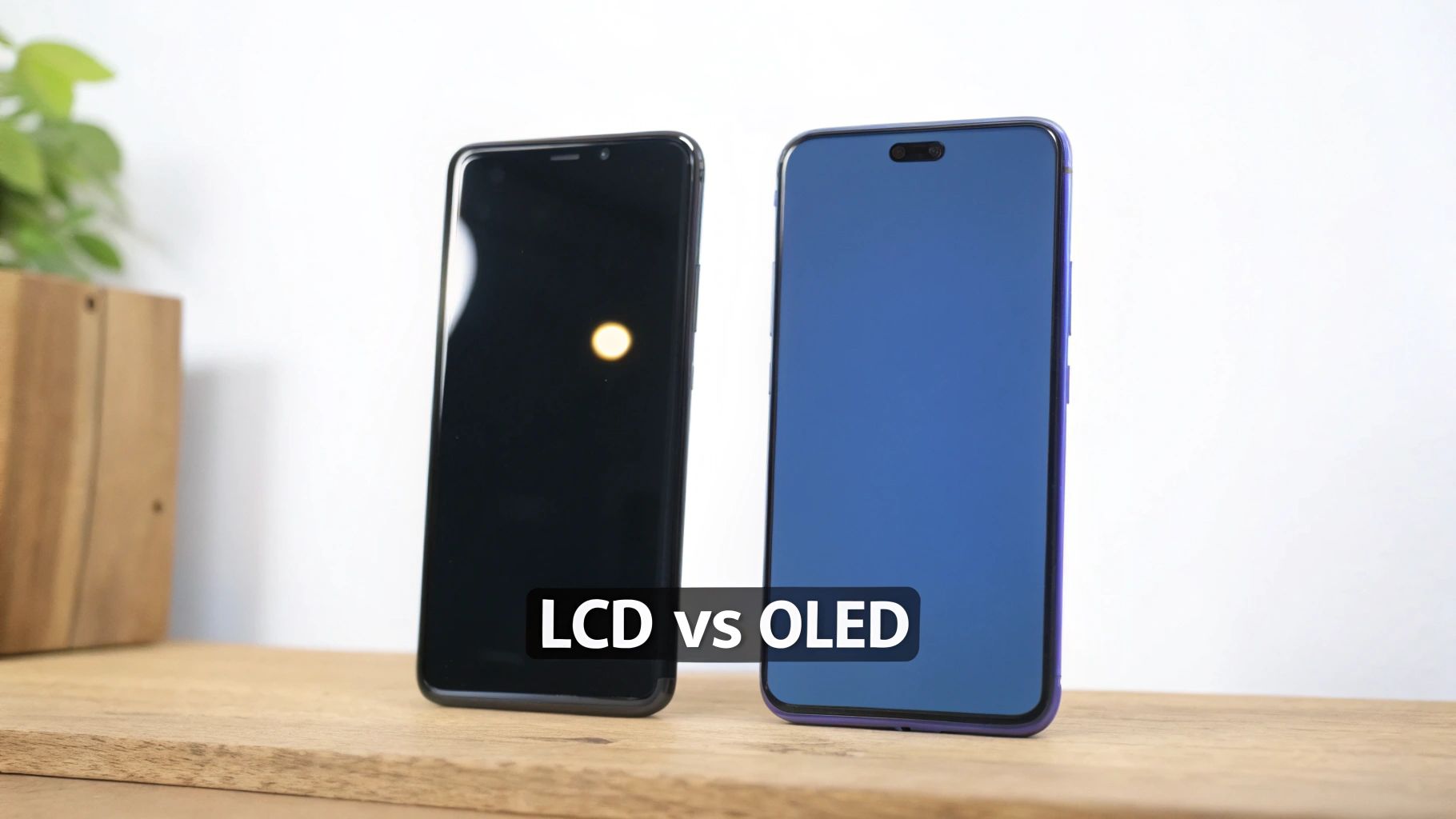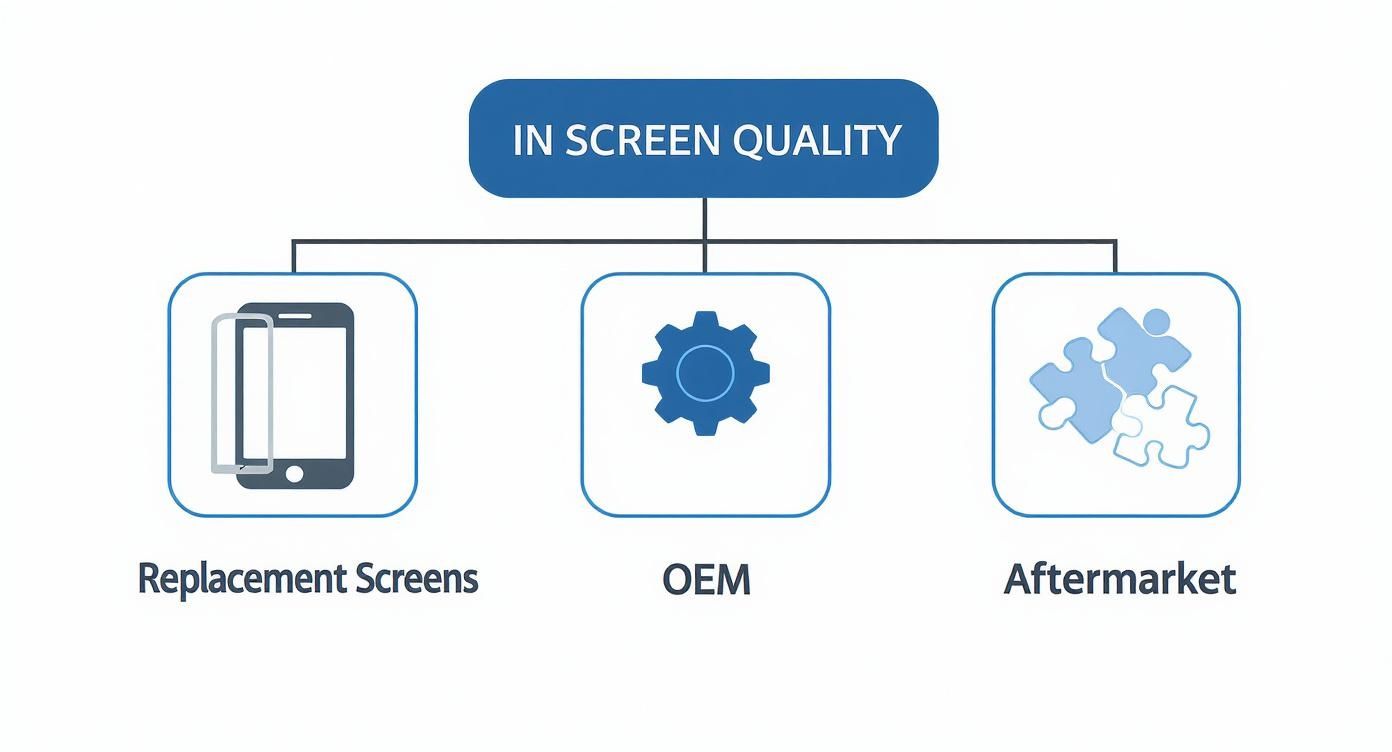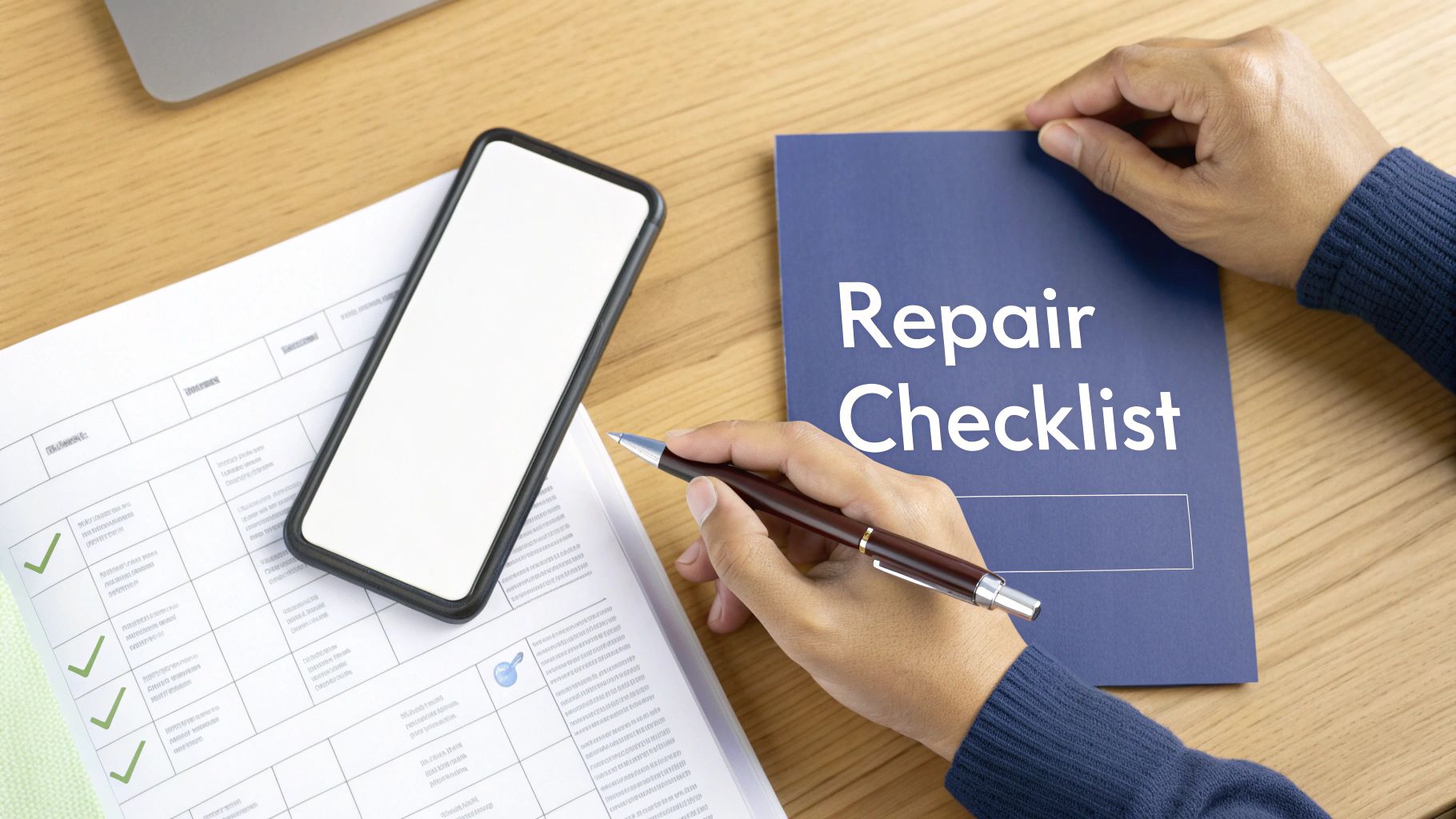We’ve all felt that heart-stopping lurch. That split-second of silence, followed by the sickening crunch of your phone hitting the pavement. It’s a terrible feeling, but a shattered screen doesn’t have to mean the end for your device. In fact, opting for a quality screen replacement is one of the smartest, most cost-effective, and environmentally friendly choices you can make. This guide will walk you through everything you need to know to get your phone looking and working like new again.
Why Replacing Your Screen Is a Smart Move
When you flip your phone over and see that spiderweb of cracked glass, the first question is always, "Now what?" Your mind might jump straight to the eye-watering cost of a new phone, but hang on—there's a much better way to handle this.
Choosing the right replacement phone screens brings your device back to life without the massive expense of a brand-new model. It’s not just about saving a few hundred dollars; it's about making a practical, sustainable decision. A good repair extends the life of your phone, keeping perfectly good electronics out of our landfills and cutting down on e-waste.
The Real Benefits of a Screen Repair
A cracked screen is more than just an eyesore. If you ignore it, you’re risking bigger problems down the line, from dodgy touch sensitivity to letting dust and moisture creep into your phone’s guts. Fixing it quickly pays off in several ways:
- Restored Functionality: A new screen gives you back that flawless touch response and crystal-clear display. It makes your phone feel brand new again.
- Enhanced Safety: No more worrying about slicing your fingers on sharp, jagged glass. A smooth new screen is a safe screen.
- Improved Device Longevity: The screen is your phone's first line of defence. By fixing its most vulnerable part, you're protecting it from further damage and making sure it lasts.
Think of a quality screen repair as an investment in the phone you already own. It saves you from the unnecessary cost and the sheer hassle of setting up a new device, transferring all your data, and getting used to new features.
At the end of the day, understanding your options for iPhone repairs Brisbane or for any other model puts you in control. It empowers you to make a call that saves you money and a whole lot of frustration. Let's dive into what you need to know to get your phone back in top shape.
alt="Technician's hands carefully installing a replacement phone screen."
Understanding Different Types of Phone Screens
When you're faced with a cracked phone, it's easy to think all replacement screens are the same. But that couldn't be further from the truth. Knowing what’s behind the glass is your first step to a top-quality repair. You aren't just replacing a piece of glass; you're replacing the very technology that lights up your digital life.
For the most part, this choice boils down to two dominant technologies: LCD and OLED.
Think of an LCD (Liquid Crystal Display) like a sophisticated billboard. It uses a single, constant backlight that shines through a layer of tiny liquid crystals. These crystals act like little shutters, twisting open and closed to let specific colours of light pass through, which is what forms the image you see on your screen.

alt="A vibrant, high-quality OLED replacement phone screen."
On the other hand, an OLED (Organic Light Emitting Diode) screen is more like a massive stadium scoreboard made up of millions of individual light bulbs. Each tiny pixel produces its own light, meaning it can be turned on or off completely on its own. This fundamental difference has a huge impact on everything you do with your phone.
The Practical Differences: LCD vs OLED
The technology powering your screen directly influences everything from colour accuracy and contrast to how long your battery lasts. Getting your head around these differences is crucial, whether you're getting a simple screen fix or a more involved repair.
Here’s a quick rundown of what sets them apart:
- Colour and Contrast: Because each OLED pixel can switch off entirely, they produce true, deep blacks and a virtually infinite contrast ratio. This makes colours pop and look incredibly vibrant. LCDs, with their always-on backlight, can only simulate black, which often ends up looking more like a dark grey.
- Energy Efficiency: OLED screens are generally much kinder to your battery. When you're looking at dark images or using your phone's dark mode, the black pixels are simply turned off and draw zero power. This can make a noticeable difference to your battery life.
- Cost and Lifespan: LCD technology has been around for ages, so it’s typically cheaper to produce. This often makes LCD replacement screens a more budget-friendly choice. OLEDs can be more expensive and, over a very long period, may be susceptible to "burn-in," although this is pretty rare with modern devices.
The choice between LCD and OLED often comes down to the original manufacturer's design. High-end phones from brands like Samsung and Apple (in recent models) favour OLED for its superior visual quality, while many mid-range and older models use dependable LCDs. For a deeper dive, check out our guide on the differences between LCD, OLED, and AMOLED replacement screens.
To make things even clearer, here’s a quick side-by-side comparison.
LCD vs OLED Replacement Screens at a Glance
This table breaks down the two dominant screen technologies to help you understand the options for your phone repair.
| Feature | LCD (Liquid Crystal Display) | OLED (Organic Light Emitting Diode) |
|---|---|---|
| Black Levels | Simulates black (can appear grey) | True, deep black (pixels are off) |
| Contrast | Good | Excellent, near-infinite |
| Colour | Natural and accurate | Vibrant and punchy |
| Power Use | Consistent power draw | More efficient, especially with dark mode |
| Thickness | Generally thicker due to backlight | Thinner and more flexible |
| Cost | More affordable | More expensive |
| Burn-In Risk | None | Very low risk over a long time |
Ultimately, both technologies have their place, but knowing which one your phone uses helps set the right expectations for your repair.
Why Screen Size and Resolution Matter
Beyond the core display tech, the physical specs of a replacement screen are critical for a perfect repair. The Australian smartphone market is incredibly diverse, with a huge range of screen sizes and resolutions out there. A professional repairer needs to stock a massive array of parts to ensure they have the exact match for your device. This variety is precisely why expert knowledge is so important—it guarantees you get the right part for a seamless, factory-quality finish.
OEM vs Aftermarket: Choosing the Right Quality Screen
Alright, you've got the tech side of things down. Now, let's talk about the next piece of the puzzle: the quality of the replacement screen itself. When you're looking to get your phone fixed, you'll find there are a few different tiers of replacement phone screens out there. Knowing the difference is what separates a great, long-lasting repair from a dud.
The whole world of replacement parts really boils down to two camps: OEM and aftermarket. The best way to think about it is like getting your car serviced. You can use parts straight from the original car manufacturer, or you can go with trusted parts from a third-party company. Both will get you back on the road, but they strike a different balance between cost and quality.
What Are OEM Replacement Screens?
OEM is short for Original Equipment Manufacturer. Simple enough, right? These are screens made by the exact same companies that produced the original display for your phone. When you choose an OEM screen, you're getting a part that's straight from the factory, guaranteeing a perfect match in colour, brightness, touch response—everything.
Because they come directly from the source, OEM screens are the undisputed gold standard for quality and reliability. That premium quality, however, comes with a premium price tag. They're the most expensive option on the table, but for a lot of people, that peace of mind is well worth the extra cash.
Choosing an OEM screen is like turning back the clock and restoring your phone to its original, out-of-the-box condition. You're not making any compromises, so your device will look and feel exactly as it did the day you bought it.
This is especially critical for high-end phones where things like super-smooth refresh rates and perfect colour accuracy are a huge part of the experience.
Exploring the World of Aftermarket Screens
Aftermarket screens are made by third-party companies, not by the original manufacturer of your phone. And this is where things can get a bit wild. Just like with those car parts, the quality of aftermarket screens can vary from impressively good to just plain awful. This is the main reason why quotes for iPhone Repairs Brisbane can be all over the map from one shop to the next.
A good, reputable repairer—like us here at Screen Fixed Brisbane—makes it their business to source top-quality aftermarket parts that get incredibly close to OEM performance without that hefty price. These high-tier aftermarket screens are a fantastic sweet spot, balancing great function with affordability.
But then there's the other end of the spectrum. The market is absolutely flooded with cheap, low-grade screens, and using one can lead to a whole host of headaches:
- Poor Colour Accuracy: Colours might look washed out and dull, or even have a weird blue or yellow hue to them.
- Reduced Brightness: The screen just won't get as bright as the original, making it a struggle to see clearly in the sun.
- Touch Sensitivity Issues: Ever tried typing on a screen that lags or just doesn't register your taps? It's infuriating. That's a common problem with cheap screens.
- Lower Durability: Cheaper glass often means weaker glass. It's far more likely to scratch or crack, landing you right back where you started.
The Australian smartphone repair scene is a big slice of a global industry that's expected to rocket from USD 20.98 billion in 2025 to almost USD 45.52 billion by 2035. When flagship phones can set you back over $1,500, getting a professional screen replacement for less than 20% of that price is a seriously attractive option. This is what fuels the demand for quality parts and repairs. You can discover more insights into the global repair market and see just how much it's growing.
Ultimately, picking a trusted professional is your best bet to ensure you get a high-quality aftermarket screen and dodge the pitfalls of those cheap, inferior parts. It’s the smart way to get your phone looking new again without paying top dollar for an OEM component. Don't be afraid to ask your repair shop about the quality of the parts they're using—a good one will be happy to tell you.
The Risks of DIY vs The Reliability of Professional Repair
So, you’ve cracked your screen. The first impulse for many is to jump online, find a cheap DIY kit, and try to tackle the job themselves. It seems like a smart way to save a few dollars, but this path is littered with hidden dangers that can quickly turn a simple fix into an expensive nightmare.
Trying to replace a screen at home is a lot more complicated than the average YouTube tutorial lets on. Modern smartphones are incredibly intricate, packed with tiny, delicate components that are easy to break. Without the right specialised gear—think heat guns, spudgers, and precision screwdrivers—you're more likely to cause more damage than good. A single lost screw or a yank on the wrong ribbon cable can be all it takes to kill your device for good.
The Hidden Costs of a DIY Mistake
One of the biggest traps in a home repair is the high risk of damaging other sensitive parts. For instance, the delicate sensors that control Face ID on an iPhone are notoriously fragile. If you damage them while swapping the screen, that feature is gone forever—a costly problem that a simple screen replacement should never cause.
Another common pitfall is accidentally destroying your phone's water resistance. Professionals use specific adhesives and proven techniques to properly re-seal a device, something that’s nearly impossible to get right at home. A poorly sealed phone is left wide open to moisture and dust, setting you up for much bigger headaches down the track.
A botched DIY repair often ends up costing far more than a professional service would have in the first place. When you add up the price of the kit, the risk of breaking other components, and the fact that you get zero warranty, going to a pro is almost always the smarter financial move.
This infographic gives you a clear breakdown of the different quality tiers for replacement screens, from the best OEM parts right down to the cheapest aftermarket options.

alt="Infographic showing the quality tiers of replacement phone screens, from OEM to low-grade aftermarket."
Understanding this hierarchy is crucial. Professionals have access to high-quality parts that you simply won't find in most DIY kits.
The Peace of Mind a Professional Provides
Opting for a professional service completely sidesteps all these risks. Technicians have the hands-on experience, the correct tools, and access to high-quality replacement phone screens to get the job done right the first time, every time.
Here's what you're really paying for:
- Expertise and Efficiency: Our technicians do these repairs all day, every day. They know exactly what they're doing, ensuring a quick and perfect installation.
- Guaranteed Quality: We only use premium parts that bring your phone's display back to its original glory, both in looks and performance.
- Warranty Protection: Every single one of our repairs is backed by a warranty, giving you complete confidence and peace of mind.
If you're still leaning towards giving it a go yourself, at least go in with your eyes wide open. You can get a better sense of what's involved by reading up on how to fix a cracked iPhone screen at home. Ultimately, though, trusting an expert means your device is in safe hands, protecting its value and making sure it works just as it should for years to come.
How to Make a Smart Choice for Your Phone Repair
Alright, let's pull it all together. Navigating the world of replacement phone screens can feel like a bit of a maze, but it’s simpler than it looks once you know what to watch for. It really just boils down to the key things we've covered: the screen technology (LCD vs. OLED), the part quality (genuine vs. aftermarket), and whether to tackle it yourself or call in a professional.
Think of a quality repair as an investment in your phone's future. Here in Australia, where nearly 90% of us have a smartphone, a cracked screen is practically a rite of passage. In 2023, screen repairs made up a whopping 40% of all smartphone fixes globally, so you're definitely not alone. When a new flagship phone can set you back over $1,500, getting a professional repair is a no-brainer.

alt="A happy customer receiving their repaired iPhone from a technician at Screen Fixed Brisbane."
iPhone 14 Pro screen replacement in Brisbane, looking good as new.
Your Checklist Before You Repair
To feel confident you're making the right call, you need to ask the right questions. Before you hand your phone over to any repair shop—even professional iPhone Repairs Brisbane—make sure you get clear answers to these:
- What quality of replacement screen do you use? Are we talking top-tier aftermarket parts, or something closer to what the manufacturer uses?
- What warranty do you offer on your parts and labour? Any reputable shop will stand behind their work. No warranty is a huge red flag.
- How long is this going to take? This isn't just about convenience; it sets a clear expectation and shows they know their process.
- Will this repair affect any other phone functions, like Face ID or water resistance? Their answer here is a dead giveaway of their experience level.
Finding a technician you can trust is half the battle. For a deeper dive on what to look for, check out our guide on how to find affordable phone screen repair services near you.
At the end of the day, a shattered screen doesn't have to spell disaster for your device. By choosing a professional repair that uses high-quality parts, you’re not just fixing the glass—you’re giving your phone a whole new lease on life.
Disclaimer: All third-party trademarks, such as iPhone, Samsung Galaxy, and Google Pixel, are the property of their respective owners. Screen Fixed is an independent service provider and is not affiliated with these brands.
Common Questions About Phone Screen Repairs
Getting a screen fixed often brings up a few questions. To give you total clarity and peace of mind, we've put together some straight answers to the queries we hear most often from our customers around Australia.
How Much Will a Screen Replacement Cost in Australia?
The price for replacing a phone screen isn't a single, fixed number; it really depends on a couple of key things. The biggest factor is your phone's specific model—newer flagship phones with fancy displays are naturally going to cost more to fix than older models.
The screen's technology also plays a huge part. Phones with those beautiful, vibrant OLED displays, like many of the latest Samsung and iPhone models, usually have more expensive replacement phone screens than ones with standard LCDs. Finally, the quality of the part you choose, whether it's a premium aftermarket screen or a genuine original, will affect the final price. For most phones, though, a professional repair will still only be a fraction of what a new device would cost.
Will My Phone Still Be Waterproof After a Screen Repair?
This is a brilliant and very important question. When a professional technician replaces your screen, they will meticulously apply brand-new adhesive seals around the frame. The whole point of this is to restore your phone's water resistance as close as possible to how it was when it left the factory.
That said, it's important to be realistic. No third-party repair, no matter how perfectly it's done, can officially guarantee the original IP (Ingress Protection) rating that the manufacturer gave it. While the new seals give you great protection against everyday splashes and dust, we always suggest being a bit more cautious around water after any kind of repair.
How Long Does a Phone Screen Replacement Actually Take?
One of the best parts about getting a professional repair is just how quick and convenient it is. For the vast majority of popular smartphones, a screen replacement is a surprisingly fast job for a seasoned technician.
At a specialist repair shop like Screen Fixed Brisbane, most screen fixes are done in under an hour. This means you can often drop your phone off and have it back in your hands, looking brand new, in less time than it takes to grab lunch. It’s all about minimising the disruption to your day and getting your phone back where it belongs—with you.
A professional repair is built for efficiency. With the right tools, quality parts, and years of experience, a job that might take a DIYer hours of frustration can be expertly sorted in a very short amount of time.
Will a New Screen Affect My Phone's Performance?
Not at all. A high-quality screen, fitted by a professional, shouldn't negatively impact your phone's performance in any way. In fact, the goal is to bring your phone's functionality right back to its original state, making sure the touch sensitivity, colour accuracy, and brightness are just as you remember them.
Performance problems—like an unresponsive screen, "ghost" touches, or issues with Face ID—almost always come down to two things: cheap, low-grade parts or a botched installation. This is precisely why it's so critical to steer clear of those questionable DIY kits and choose a reputable repairer who only uses premium replacement phone screens. It’s the best way to protect your phone's performance for the long run.
A cracked screen is an easy fix when you leave it to the experts. Book your repair with Screen Fixed Brisbane today.

